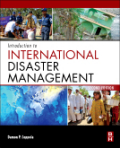
Written from a global perspective on risk, hazards, and disasters, Introduction to International Disaster Management provides practitioners, educators and students with a comprehensive overview of the players, processes and special issues involved in the management of large-scale natural and technological disasters. The book discusses special issues encountered in the management of international disasters, and explains the various private, non-governmental, national, and international agencies that assist in preparedness, mitigation, response and recovery during national and regional events. Concentrating on the four major phases of emergency management - mitigation, preparedness, response, and recovery - Introduction to International Disaster Management deals with such timely topics as Hurricane Katrina, the 2004 Asian tsunami, and SARS. It also serves as a reference to governmental and other agencies involved in international disaster management activities. This book is the first of its kind to take a global approach to the topic of international disaster management. Serves as the first comprehensive resource dealing with the issues of internationaldisaster management* Contains numerous case studies, examples of Best Practices in international disaster management, and a contact list of the governmental and nongovernmental agencies involved in international disaster management* Provides a global perspective on risk, hazards, and disasters that is written both for students within disaster management programs and for professionals entering the field"Damon Coppola's Introduction to international disaster management is a single volume sourcebook that makes excellent use of full colour graphics and has numerous inset boxes highlighting aspects of the topics under discussion. The book follows a logical progression starting with the history of disasters and ending with details of disaster management agencies (governments, NGOs, multilateral organisations), where they are located within national government structures, and what they do. The bulk of the book is given over to consideration ofhazards, risks and vulnerability, and the four stages of traditional disastermanagement namely: mitigation, preparedness, response, and recovery. A final chapter deals briefly with special considerations in relation to disasters covering such diverse topics as the media, political will, donor fatigue, state sovereignty, climate change, terrorism, and pandemics. This book is an excellent starting point for the study of disaster planning providing both global perspective and local detail."--Colin Perry, The Brunei Times
- ISBN: 978-0-12-382174-4
- Editorial: Butterworth-Heinemann
- Encuadernacion: Cartoné
- Páginas: 696
- Fecha Publicación: 08/04/2011
- Nº Volúmenes: 1
- Idioma: Inglés
